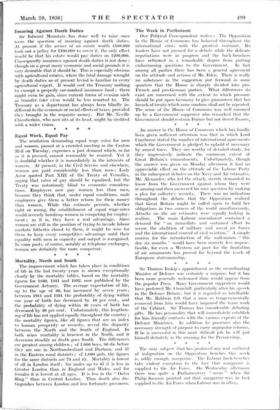Mortality, North and South The improvement which has taken place
in conditions of life in- the last twenty years is shown exceptionally clearly-by the mortality tables, based on the mortality figures for 1930, 1931 and 1932, now published by the Government Actuary. The average expectation of life, up to the age of 60, has increased by seven years ; between 1911 and 1931 the probability of dying within one year of birth has decreased by 40 per cent., and the probability of dying within 40 years of birth has decreased 'by 30 per cent. Unfortunately, this lengthen- ing of life has not applied equally throughout the country ; the mortality figures, like all figures that are an index to . human prosperity or security, reveal the disparity between the North and the South of England. In both sexes mortality is heaviest in the North, and it decreases steadily as death goes South. The differences are greatest among children ; of 1,000 boys, 96 die before they are one in Northumberland and Durham, and 57 in the Eastern rural districts ; of 1,000 girls, the figures for the same districts are 73 and 45. Mortality is lowest of all in London itself ; for males up to 45 it is less in Greater London than in England and Wales, and for females it is lowest at all ages. It is less in the " Outer Ring" than• in Central London. Thus death also dis- tinguishes between London and less fortunate provinces.


































































 Previous page
Previous page